ANTARCTICA AND FALKLAND ISLANDS
__________________
__________________
Day Place Highlights
Day 1 Ushuaia Set sail, meet the expedition team
Day 2 At Sea Enjoy the facilities onboard, fine dining options, welcome cocktail party
Days 3 - 5 Falkland Islands New Island, West Point Island, Bleaker Island, Sea Lion Island
Day 6 Drake Passage Onboard lectures, photography workshops, spa treatments, exquisite dining experiences
Day 7 Elephant Island, South Shetland Islands Chinstrap penguins, elephant seals, macaroni penguins, weddell seals
Day 8 Antarctic Sound Hope Bay, Paulet Island
Days 9 - 12 Antarctic Peninsula Iceberg sculptures, carving glaciers, marine mammals, penguins
Days 13 - 15 Drake Passage Cross the Drake Passage bound for Ushuaia
Day 16 Ushuaia Farewell your expedition team and fellow travellers
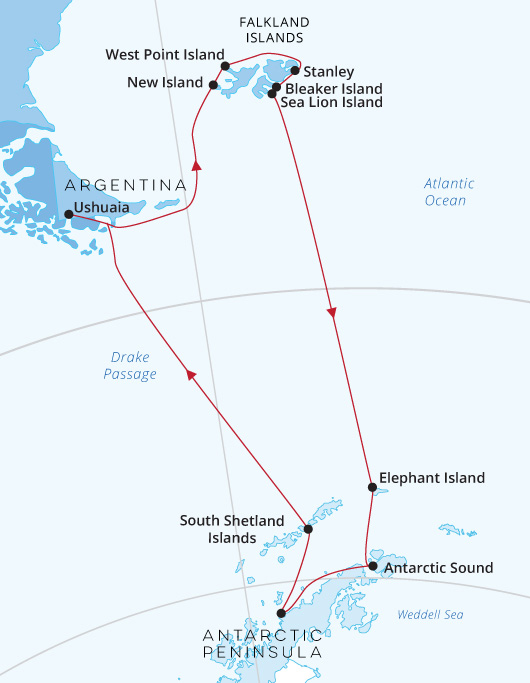
Spacious yet intimate, the yacht-like Silver Cloud carries 240 guests in incomparable comfort and style combining spacious ocean-view suites and private verandas with excellent dining and entertainment options. Silver Cloud epitomizes a vision of world-class cruise accommodations, cuisine, service and amenities. The Silver Cloud is equipped with a fleet of zodiacs and expert guides to escort you on excursions from the ship.
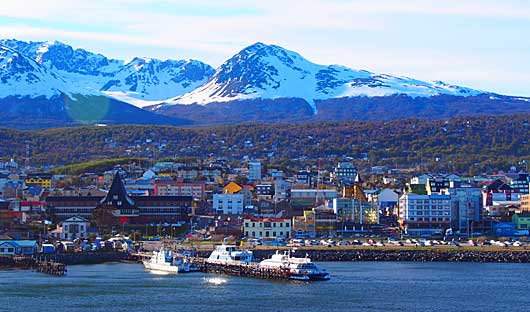
At 55 degrees latitude south, on the Southern most tip of Argentina, Ushuaia is closer to the South Pole than to Argentina’s northern border with Bolivia. It is the capital and tourism base for Tierra del Fuego National Park.
Today embark on your voyage to Antarctica via the Falkland Islands. After you settle in to your cabin you will have a safety drill and meet your fellow travellers.
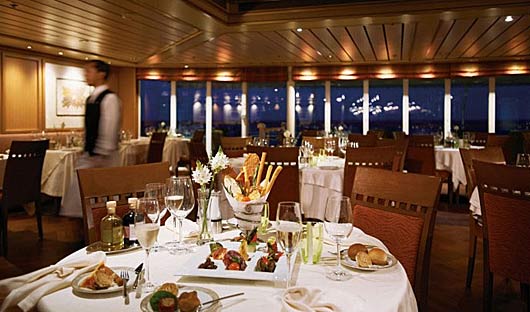
Taking advantage of the day at sea, the Expedition Team will present talks about the Falkland Islands (Malvinas -as the Spanish-speaking world calls them) that will prepare you for the exciting adventures ahead. Birders out on deck want to keep an eye out for Black-browed Albatross, Southern Giant Petrels and Cape Petrels.
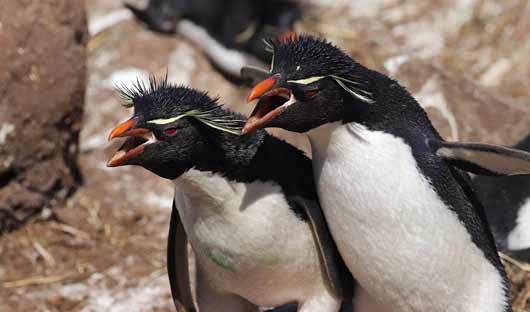
Today you have two opportunities to enjoy the remarkable beauty of the remote Falkland Islands. During the morning we will visit New Island, a wildlife and nature reserve. The New Island Conservation Trust, a private environmental conservation group, protects its many birds and animals. Our Zodiacs will take us ashore near the island’s small settlement at Coffin Harbour. From there we will hike past the Barnard Memorial Museum crossing the island from east to west to reach the rocky cliffs and a rookery where Rockhopper Penguins and Blue-eyed Shags share the same nesting area. We will also observe Black-browed Albatross going about their daily routines and may even spot Upland Geese on our hike.
Our on-board historian might tell us about ‘Barnard’s barn’ — a stone structure once belonging to an early settler and now a museum, as well as the wreck of Protector III — an old minesweeper used for seal hunting, now grounded just off the shore not too far from our landing site.
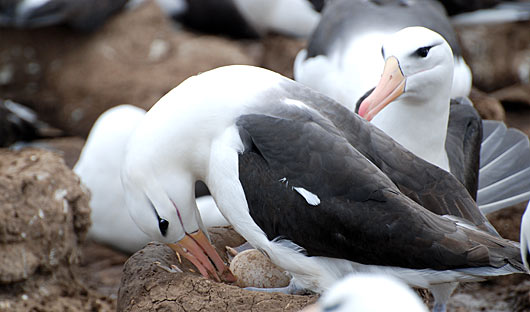
During lunch Silver Cloud will sail in a northeasterly direction to West Point Island. Peale’s dolphins and Commerson’s dolphins with their distinctive black and white markings can often be spotted as one approaches West Point Island. Our Zodiacs will take us to a jetty from where we will walk slightly less than 2 miles to Devil’s Nose. Walking across rolling moorland and past gorse we will be observed by Grass Wrens, Long-tailed Meadowlarks, Falkland Thrushes, Striated Caracaras and Turkey Vultures, but our goal is to reach colonies of Black-browed Albatross that nest side-by-side with Rockhopper Penguins. The winds at Devil’s Nose are usually so strong that the albatross only have to spread their wings to take off, while the penguins (as their name implies) have to hop from rock to rock to reach either the shore or their nests. Once back at the farm, the hospitable island owners will invite you to have tea, coffee and home-made cakes and cookies and are always happy to answer your questions and share their stories.
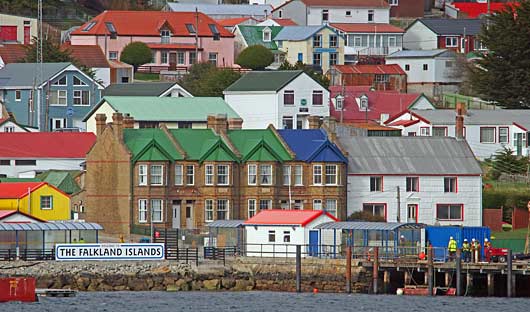
Stanley is the capital of the remote Falkland Islands, and –although Argentine authorities have repeatedly claimed the islands as part of their country- has a distinct British ambiance. A reminder of the 1982 Falkland War between Britain and Argentina is the War Memorial.
Opt to take a ‘city tour’ by bus with a local guide or stroll through the charming streets of this colourful little town, lined with quaint cottages and a variety of traditional pubs. Visit the 19th-century Anglican cathedral (the southernmost Anglican cathedral in the world) and wander through the Falkland Islands Dockyard Museum. For stamp collectors a visit to the Philatelic Bureau is a must. Depending on local conditions there might be the chance to see Gentoo, Magellanic or King Penguins at Bluff Cove or Volunteer Point.

Bleaker Island is privately owned with sheep and Hereford cattle grazing on the lush green grass. This is an excellent site for birding. The Bleaker Island Group is recognised as an important bird area and its northern part is a national nature reserve.
As you may suspect, Sea Lion Island is home to southern sea lions as well as elephant seals. Here you may also be lucky enough to see orcas (killer whales) who feed on the penguins and seals found in this region.
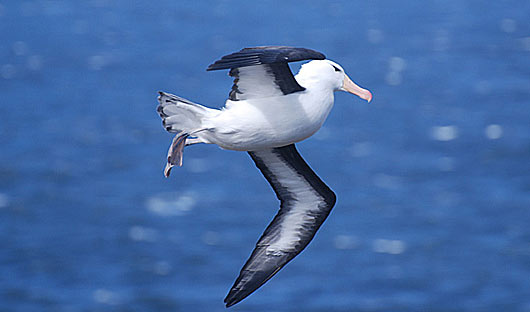
Leaving the Falkland Islands behind, Silver Cloud will head for the South Shetland Islands and Antarctica.
The day at sea will be used to present further lectures. As we are heading for Elephant Island, our on-board Historian might talk about Shackleton’s Endurance expedition and the crew members awaiting their rescue at Point Wild, while our Marine Biologist and Ornithologist will cover the wildlife to be seen.
As part of the preparation to visit Antarctica, briefings regarding correct procedures when going ashore and a thorough inspection of clothing and outdoors gear will take place. Participate in other on-board activities or peruse an array of titles and topics in the well-stocked Library. Take a stroll on deck and enjoy the solitude and splendour of the vast sea and sky.
The Drake Passage has a notorious reputation for its turbulent seas due to strong westerly winds and the currents pushed through the ‘narrow’ gap between South American and the Antarctic Peninsula. The Antarctic Convergence is a natural boundary where cold polar water flows northward and warmer equatorial water moves southward. When these currents meet, nutrients are pushed to the surface, often attracting a multitude of seabirds and whales. Spend some time on deck watching the horizon and the variety of seabirds that glide in the air currents of our ship’s wake such as the Black-browed Albatross, Sooty Shearwaters, and White-chinned Petrels. Take this opportunity to attend additional presentations offered by the Expedition Team lecturers as you travel towards Antarctica.
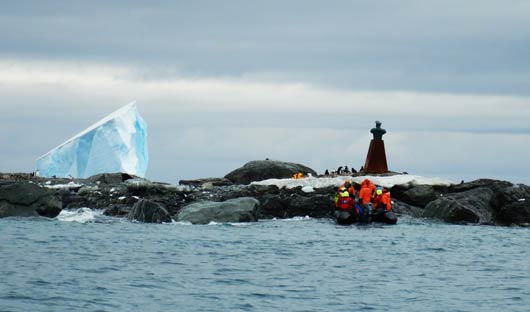
Awesome glaciers greet us as we approach Elephant Island – so named for its former abundance of elephant seals. In 1916, when Ernest Shackleton’s ship Endurance was crushed in pack ice in the Weddell Sea, the crew was stranded here for 105 days. Elephant Island is home to several Chinstrap Penguin rookeries, as well as old moss colonies. Weddell seals and Macaroni Penguins can also be found on the spit of land Shackleton’s men named Point Wild. A solitary statue can be seen there, honouring the Chilean pilot Luis Pardo, who took the cutter Yelcho across the Drake Passage to rescue Shackleton’s men.
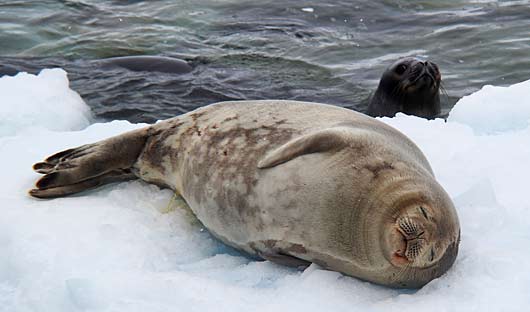
While sailing along the Antarctic Peninsula, every turn can reveal a new and breath-taking adventure. As the pack ice becomes thicker, it’s apparent to everyone that we are moving closer into Antarctica’s vast white wilderness. Remote and otherworldly, Antarctica is irresistible for its spectacular iceberg sculptures and calving glaciers, and for the possibility of up-close encounters with marine mammals. Watch for seals sunbathing on slow-moving ice floes and for humpback, Minke, and orca whales to surface from below the frigid waters. Each day we will attempt Zodiac departures, and, if conditions permit, we will cruise amidst colourful icebergs or step ashore to visit a variety of penguin rookeries and perhaps scientific research stations on complimentary excursions led by our team of natural history experts.
A flexible itinerary allows us to take advantage of favourable sea and weather conditions. In the true spirit of expedition cruising, each day the Expedition Leader and Captain will determine our best course depending on weather, ice conditions and wildlife we may encounter.
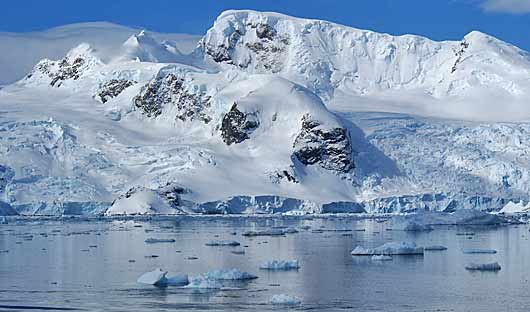

Here are some of the places we may visit:
Antarctic Sound
Named after Nordenskjöld’s ship, this 30 miles long stretch of water at the north end of the Antarctic Peninsula offers some of the best tabular iceberg observations.
Brown Bluff, Tabarin Peninsula
Brown Bluff is an ice-capped, 745-metre-high, flat-topped mountain with a prominent cliff of reddish-brown volcanic rock. Adelie and Gentoo Penguins, Kelp Gulls, and Cape Petrels use this as a breeding area. Birds such as the all-white Snow Petrel and skuas may be seen from a distance.
As you explore the area, Weddell seals may be seen basking in the sunlight. If conditions permit, a hike onto a nearby glacier might be possible.
Cuverville Island, Errera Channel
The island was discovered during de Gerlache’s Belgica expedition of 1897–99, and was named for a vice-admiral in the French navy. The large, bare rock areas near the shore provide nesting sites for Gentoo Penguins, but the penguins also look for exposed rocks on the slopes. Snow Petrels and Pintado Petrels may be seen, and Wilson’s Storm Petrels nest in the higher scree of the island.
Depending on conditions a hike towards the top of the island for stunning panoramic views might be offered. During Zodiac tours, we hope to see hauled-out Weddell seals.
Paradise Bay (on the Antarctic Peninsula)
The bay is well named for its spectacular scenery of mountains, glaciers and icebergs. From the ship, observe Argentina’s “Base Almirante Brown”, one of many Antarctic research stations. Here, you can actually set foot on the continent of Antarctica. Close to the station Gentoo Penguins, Blue-eyed Shags, Antarctic Terns, Kelp Gulls and skuas have all been seen nesting.
Depending on the conditions we can view the wildlife from sea level while cruising in our Zodiacs or cruise the bay with Silver Cloud. There’s a good chance you’ll come across a crabeater seal relaxing on a nearby ice floe, or, if you’re very lucky, your Zodiac driver may locate a Minke whale.
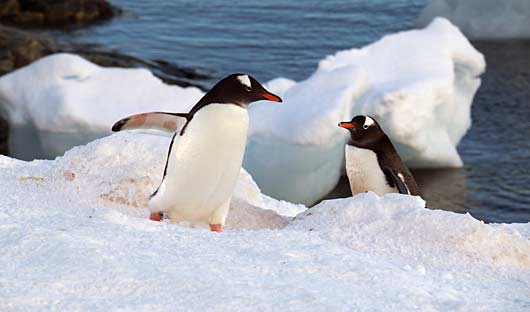
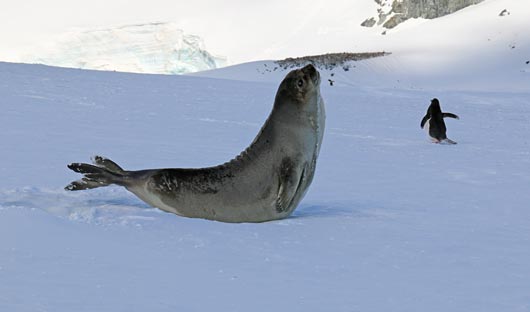
Neko Harbor
The site is named after a whale factory ship, which often used this bay –and Neko Harbor still today offers good chances to see whales. A landing will provide an opportunity to see Gentoo Penguin rookeries and quite possibly Weddell seals and crabeater seals hauled out on the cobble beach. A hike to a lookout point will be a good exercise and will be rewarded with panoramic views of the glacier, Andvord Bay and the Gerlache Strait.
Port Lockroy, Goudier Island
The British built a listening station on Goudier Island during WWII, which was then used as a research station in the 1950s. Bransfield House was restored in 1996 and since then has acted as a museum and gift shop. The Antarctic Heritage Trust operates a post-office at the station, which is open during summer.
Snowy Sheathbills and Gentoo Penguins roam outside the museum and leopard seals often patrol the sea.
Port Foster, Whalers Bay (Deception Island)
Deception Island is an excellent example of a caldera where it is believed that the volcano’s summit collapsed with one section sinking far enough to allow the sea to flood the interior. We plan to sail into the caldera through a narrow entrance called Neptune’s Bellows and anchor in sight of the former whaling station and the former British Antarctic Survey station.
Our resident geologist will take the opportunity to explain the unique volcanic features of the area and their importance for science, while our historian might introduce you to the whaling history of Deception Island. Still visible on the island are the boilers used to make whale oil in the early 1900s.
Conditions permitting, we might hike to Neptune’s Window for spectacular panoramic views.
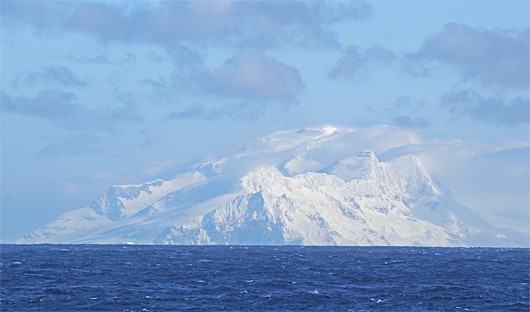
As you venture back to Ushuaia via the Drake Passage you can enjoy the onboard facilities as well as swapping photos with your fellow travellers. Continue to look out for Black-browed Albatross, Sooty Shearwaters, and White-chinned Petrels. There will continue to be presentations offered by the Expedition Team.
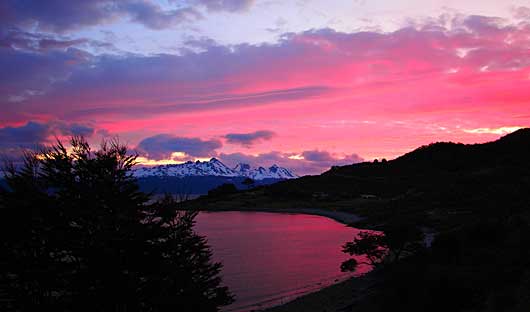
After breakfast, disembark Silver Cloud and transfer to Ushuaia International Airport for your return flight to Buenos Aires.
Expedition highlights and wildlife listed here are possible experiences only and cannot be guaranteed. Your Expedition Leader and Captain will work together to ensure opportunities for adventure and exploration are the best possible, taking into account the prevailing weather, wildlife activity and ice conditions. Expedition Team members scheduled for this voyage are subject to change or cancellation.
A flexible itinerary allows us to take advantage of favourable sea and weather conditions. In the true spirit of expedition cruising, each day the Expedition Leader and Captain will determine our best course depending on weather, ice conditions and wildlife we may encounter.